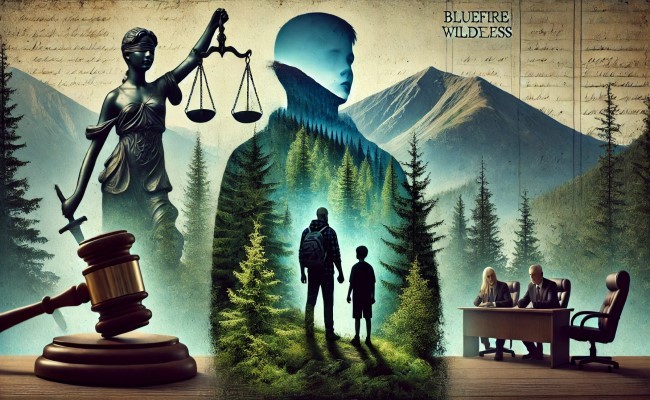Bluefire Wilderness Lawsuit: Legal Battles and the Impact on Wilderness Therapy Programs
Understanding the Legal Challenges Facing Bluefire Wilderness Therapy and What It Means for the Industry

The “Bluefire Wilderness lawsuit” has brought significant attention to the practices of wilderness therapy programs. The lawsuit, involving allegations of mistreatment and negligence, underscores the complexities and potential risks associated with therapeutic wilderness programs. This legal case is pivotal in shaping the future of wilderness therapy, raising questions about the balance between therapeutic intervention and safety in these programs.
Introduction
The wilderness therapy industry has long been viewed as a beacon of hope for struggling teens and their families, offering a unique blend of outdoor adventure and therapeutic intervention. However, recent legal challenges, most notably the “Bluefire Wilderness lawsuit,” have cast a shadow over this sector. This article delves into the specifics of the Bluefire Wilderness lawsuit, examining its implications for the wilderness therapy industry and the broader conversation around mental health treatment in unconventional settings.
Understanding the Bluefire Wilderness Lawsuit
The Origins of the Lawsuit
The Bluefire Wilderness lawsuit originated from a series of complaints made by former participants and their families. Allegations of negligence, emotional distress, and physical harm have been central to the case, with plaintiffs asserting that the program failed to provide the care and oversight necessary to ensure the safety and well-being of its participants. The lawsuit has brought to light the challenges of regulating wilderness therapy programs, which often operate in remote locations with limited oversight.
Key Allegations
At the heart of the lawsuit are claims that Bluefire Wilderness did not adequately protect its participants from harm. Specific allegations include:
- Negligence in Supervision: Plaintiffs argue that the program failed to provide sufficient supervision, leading to incidents of injury and emotional trauma.
- Inadequate Medical Care: There are claims that participants did not receive timely medical attention when needed, exacerbating health issues.
- Emotional and Psychological Harm: The lawsuit also highlights the psychological toll that the program allegedly took on participants, with reports of anxiety, depression, and PTSD following their time in the program.
Legal Proceedings and Outcomes
As the lawsuit has progressed, it has drawn significant media attention, sparking debate about the efficacy and safety of wilderness therapy programs. The legal proceedings have been closely watched by both proponents and critics of these programs, with the outcome likely to have far-reaching implications for the industry. While the case is still ongoing, it has already led to increased scrutiny of Bluefire Wilderness and similar programs.
The Impact of the Lawsuit on Wilderness Therapy Programs
Regulatory Changes and Industry Oversight
One of the most significant impacts of the Bluefire Wilderness lawsuit has been the call for stricter regulations and oversight of wilderness therapy programs. The case has highlighted the need for clearer guidelines and more rigorous standards to ensure the safety and well-being of participants. As a result, some states have begun to implement new regulations aimed at increasing accountability and transparency within the industry.
The Future of Wilderness Therapy
The outcome of the Bluefire Wilderness lawsuit could set a precedent for how similar cases are handled in the future. If the plaintiffs are successful, it could lead to a wave of lawsuits against other wilderness therapy programs, forcing the industry to reevaluate its practices and prioritize participant safety. On the other hand, if Bluefire Wilderness is exonerated, it may reinforce the current status quo, allowing programs to continue operating with limited oversight.
Public Perception and Trust
The lawsuit has also had a significant impact on public perception of wilderness therapy programs. While these programs have traditionally been seen as a last resort for troubled teens, the allegations of abuse and negligence have raised concerns among parents and mental health professionals. Rebuilding trust in the industry will require not only legal resolutions but also a concerted effort by wilderness therapy programs to demonstrate their commitment to participant safety and well-being.
The Broader Context: Wilderness Therapy and Mental Health Treatment
The Role of Wilderness Therapy in Mental Health
Wilderness therapy has been promoted as a powerful tool for addressing a range of mental health issues, from substance abuse to behavioral disorders. The combination of outdoor adventure and therapeutic intervention is believed to help participants develop resilience, self-confidence, and coping skills. However, the Bluefire Wilderness lawsuit has sparked a broader conversation about the effectiveness and safety of this approach.
Criticisms and Controversies
Even before the Bluefire Wilderness lawsuit, wilderness therapy programs had been the subject of criticism and controversy. Some mental health professionals question the efficacy of these programs, arguing that the lack of scientific evidence supporting their claims of success is problematic. Others raise concerns about the potential for abuse and the difficulties in ensuring participant safety in remote, outdoor settings.
Balancing Risk and Reward
The Bluefire Wilderness lawsuit underscores the need for a careful balance between the therapeutic benefits of wilderness therapy and the risks involved. While many participants have had positive experiences in these programs, the allegations of abuse and negligence cannot be ignored. Moving forward, the industry will need to address these concerns head-on, ensuring that the safety and well-being of participants are prioritized.
Conclusion
The “Bluefire Wilderness lawsuit” serves as a crucial reminder of the importance of oversight and accountability in the wilderness therapy industry. As the legal battle continues, it is likely to have significant implications for the future of these programs, shaping the way they are regulated and perceived. Whether the outcome leads to sweeping changes or reinforces the status quo, the case has already made a lasting impact on the conversation around wilderness therapy and mental health treatment.
Final Thoughts
As the wilderness therapy industry navigates the fallout from the Bluefire Wilderness lawsuit, it faces a critical juncture. The decisions made in the coming months and years will determine the future of these programs and their role in the broader mental health landscape. For now, all eyes are on the legal proceedings and the changes they may bring about.



